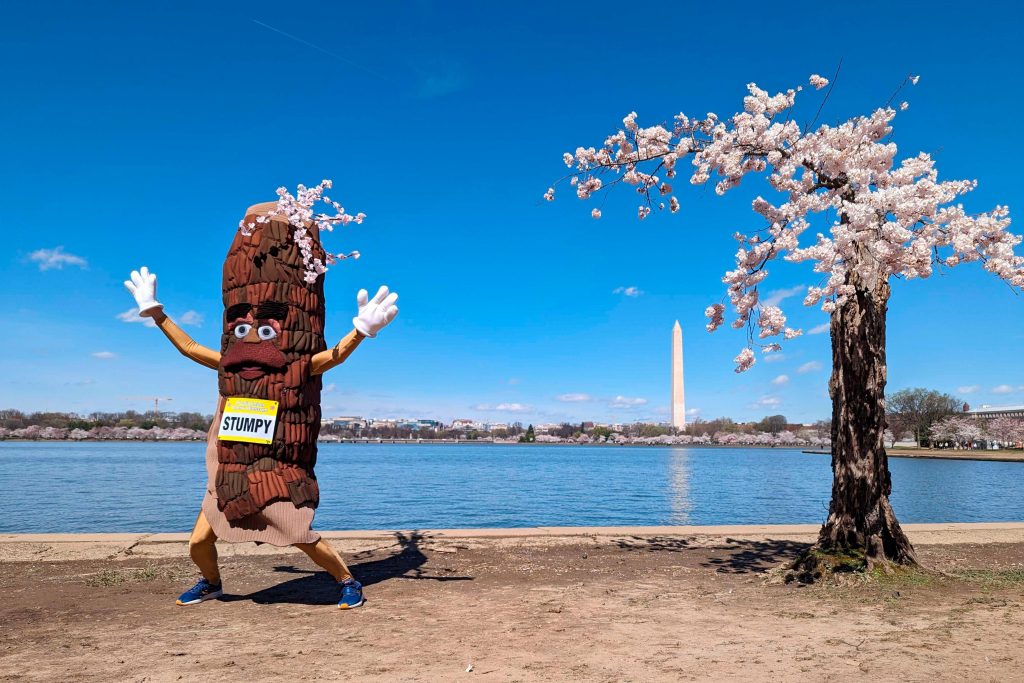By ASHRAF KHALIL (Associated Press)
WASHINGTON (AP) — The sun is setting on Stumpy, the twisted old cherry tree that has become extremely popular on social media. This year’s cherry blossom celebrations in Washington will be the final ones for Stumpy and over 100 other cherry trees that will be removed as part of a multiyear renovation of their Tidal Basin home.
Starting in early summer, crews will start replacing the decaying seawall around the Tidal Basin, the area surrounding the Jefferson Memorial with the highest concentration of cherry trees. The work has been long overdue, as the deterioration, along with rising sea levels, has led to Potomac waters regularly flowing over the barriers.
The twice-daily floods at high tide not only cover some of the walkways, they also regularly saturate some of the cherry trees’ roots. The $133 million project to reconstruct and strengthen the seawall will take around three years, said Mike Litterst, National Park Service spokesman for the National Mall.
“It’s certainly going to enhance the visitor experience, and that’s very important to us,” Litterst said. “But most importantly, it’s going to benefit the cherry trees, who right now are every day, twice a day, seeing their roots inundated with the brackish water of the Tidal Basin.” Litterst said entire stretches of trees to the water, as wide as 100 yards, or 90 meters, have been lost and can’t be replaced “until we fix the underlying cause of what killed them in the first place.”
Stumpy remains alive, if in rough shape.
Plans call for 140 cherry trees — and 300 trees total — to be removed and turned into mulch. When the project is concluded, 277 cherry trees will be planted as replacements.
The mulch will protect the roots of surviving trees from foot traffic and break down over time into nutrient-rich soil, “so it’s a good second life” for the trees being cut down, Litterst said.
The National Cherry Blossom Festival is widely considered to be the start of the tourist season in the nation’s capital. Organizers expect 1.5 million people to view the pink and white blossoms this year, the most since the coronavirus pandemic. Large numbers of cherry blossom fans have already been drawn to the area as the trees entered peak bloom on March 17, several days earlier than expected.
Stumpy became a social media star during the pandemic frenzy of 2020. Its legacy has led to T-shirts, a calendar and a fanbase. News of Stumpy’s final spring has prompted people to leave flowers and bourbon and had one Reddit user threatening to chain themselves to the trunk to save the tree.
The good news about Stumpy is that the National Arboretum plans to take parts of the tree’s genetic material and create duplicates, some of which will eventually be replanted at the Tidal Basin.
The regular flooding at the Tidal Basin — sea levels have risen about a foot since the the seawall was built in the early 1990s — is just one of the ways climate change has affected the cherry trees. Rising global temperatures and warmer winters have caused peak bloom to creep earlier in the calendar.
This year’s highest number of cherry trees blooming was expected to start on Saturday, but it was declared on March 17. In comparison, the peak bloom in 2013 started on April 9. Leslie Frattaroli, who manages the national resources program for the Park Service, told The Associated Press in February that the highest number of trees blooming could regularly happen in the middle of March by 2050.
He said, “All the timing is wrong. It's a huge cascading effect.”
Another effect of the weather: A cold snap in mid-March in the D.C. area should actually make this year’s bloom last longer than the predicted April 9 ending.
For people visiting and enthusiasts of cherry blossoms, the yearly tradition of walking around the Tidal Basin under the flowers is a key experience in Washington.
Jorge and Sandra Perez make sure to come every year from Stafford, Virginia.
“Yes, we have cherry blossoms in my community, but it’s a completely different feeling when you see all of them bloom together,” Sandra said. “And you can walk through, you know, the trees under it and smell it. And it’s just it’s a beautiful view.”
They also came looking for Stumpy, having heard the legend and knowing this would be its final spring.
“It’s actually beautiful,” Jorge said. “So it’s sad to see him leave.”
___
Corrects that peak bloom started on March 17, not that peak bloom is approaching.
___









